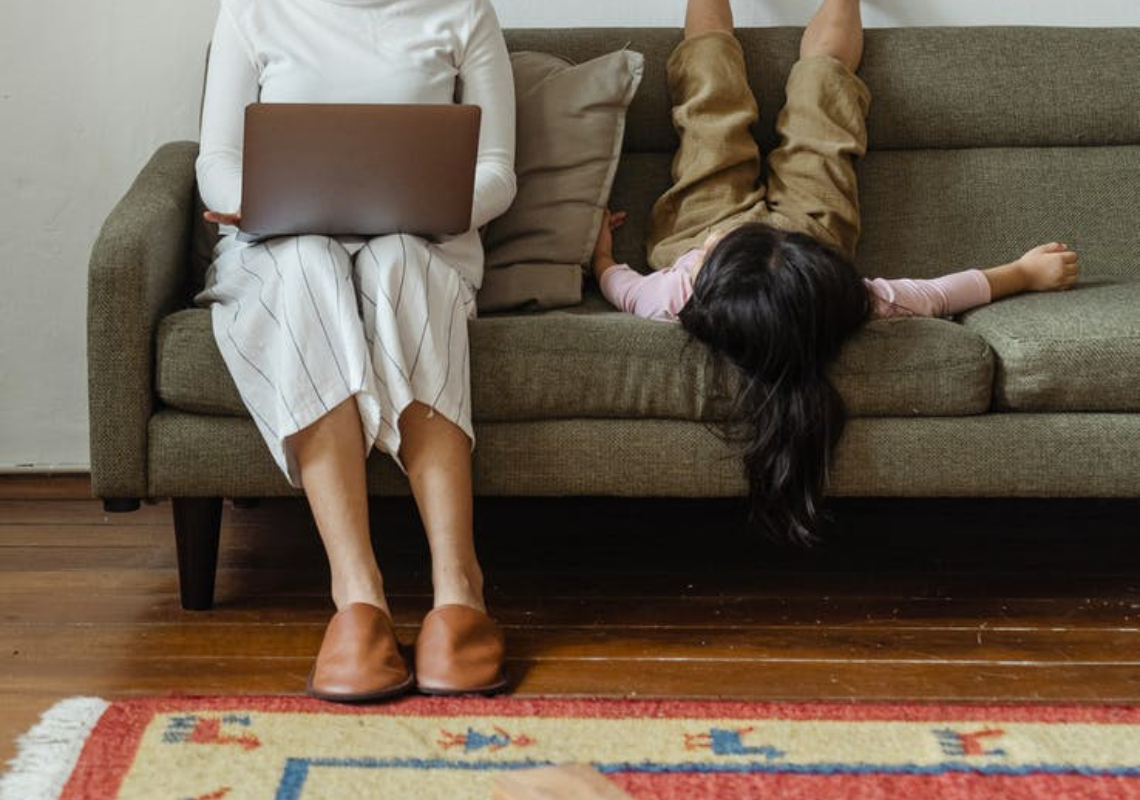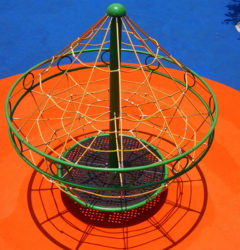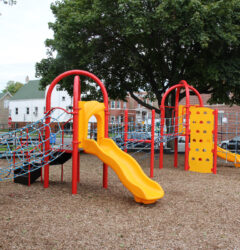21 Dec

At Dynamo Playgrounds, we understand the importance of play, and we value ways to make it easier for children to participate with their peers. Social anxiety can halt any attempt at play for some children. With approximately 8-13% of people identifying with social anxiety symptoms, we wanted to take the time to discuss ways we can all work towards reduce those anxieties for the children and youth in our lives.
While the terms shyness and social anxiety often get used interchangeably, they are definitely different. Shyness is quite common and is the general feeling of being uncomfortable in social situations. Especially around new people.
The big difference is that people who are shy can still typically motivate themselves to participate when needed. Social anxiety is an actual disorder that affects your quality of life. People with social anxiety tend to avoid certain events or undergo intense anxiety over fears of rejection or judgement. Perceived or real, it doesn’t matter.
For those of us who do not struggle with social anxiety, the signs may be difficult to spot. Shyness and social anxiety have similar symptoms, so it can be difficult to put a name to it just based on visuals. Both shyness and anxiety tend to present themselves with blushing, racing heart, sweating, maybe a nauseous stomach, like those nervous butterflies’ feelings. Social anxiety can also cause a person to feel like they have a tight chest, dizziness, numbness, migraines even, and maybe the most telling of all, it can lead to panic attacks. The anxious thoughts that remain consistently at the forefront on the mind make social anxiety a non-visible disability.
Persistent fears or intrusive thoughts that don’t necessarily go away are common in social anxiety. Fear that others will notice your anxiety, or fear that you’ll be humiliated can cause a person to overanalyze every aspect of a potential social situation. Whereas shyness tends to get better as a person become familiar with the environment or the people in it. Both can cause a lot of stress; social anxiety tends to last a lot longer with deeper impact to your daily life.
How do we recognize the signs of social anxiety in the children in our lives?
For children, it usually shows up when it comes time to make friends. Not to be confused with general separation anxiety or shyness in toddlers or younger children. Social anxiety tends to show up more in ways like withdrawing from play situations, having difficulty making new friends or joining groups at the playground. Children may have a small group of friends to play with and don’t like to deviate from that. They may also avoid social situations that make them the centre of attention – like calling out an answer in class or asking a question.
Social anxiety is not always easy to spot. Children with social anxiety tend to appear very quiet or respectful in preschool or school. They might not talk about their fears or concerns. They tend to follow along in social settings, but they may stick to the back of the class, or not raise their hand to be picked as a partner in gym class.
How can we help to improve social anxiety in children?
Acting out scenarios that may be making them feel anxious is a good start. Sometimes they just need repeated practice or role playing. If they are nervous about asking to play with a group of random children at the playground, work through all the scenarios that may be stressful for them. Are they worried the other children will say no? Validate that concern – because that’s a legit fear that most of us have at some point – and then work through what that would look like.
Can you ask to play with another child? Can we move to a different section of the playground and try again with a different crowd? Can you talk about why some kids might say no?
The tricky part about children is that, sure, maybe that particular child who says no is just mean. Or maybe they also have anxiety or perhaps they are on the autism spectrum and prefer to play alone. You just don’t ever really know, so you can’t really take it personally. All you can do is be nice first, and hope they say yes. But if they don’t, well, we move along.
Keep practicing, and sooner than later a child will inevitably say an enthusiastic YES to playing together and eases the anxiety a little bit. Each try becomes a little easier.
Being open about your own anxieties can be helpful too. Talk about why you were nervous or anxious, what you did to make it feel better. Gentle encouragement is always a great thing, at home or at school. But they shouldn’t feel forced and there shouldn’t be any scolding remarks for failing to overcome the anxiety. Again, whether at home, school, or the playground it’s important not to speak for your child. That can make things much worse. Do not announce the social anxiety or try to point out that another child should just be nice because of the anxiety. Saying stuff like “Jane is shy so please just play with her” can send a child with anxiety into a shell of themselves. If it would make you cringe if someone did that to you, then we need to make sure we don’t do it to them.
There’s a behavioural technique call The Step Ladder Approach. It involves starting with the smallest steps, or the simplest anxieties, and working on those before leaping to the use issues. Work on something simple like saying goodbye when leaving the playground, before leaping to asking to play with a new child. This is a common technique used in separation anxieties. You may start with asking your child to stay on the couch, while you run to the next room to grab and item. And then maybe the next step is to ask them to wait inside, while you go out to the car to gather groceries. Move from that to staying with the babysitter for an hour. Don’t just leap to the most stressful anxiety. Work towards that as a goal and maintain the conversation with your child the whole time so they feel in control.
For children at the playground, that might simply be starting with playing near other children. Then we can move towards saying hi and depending on the age you can even coach them how to offer to share a toy, or ask if the child wants to play. You can build up on that so that eventually, hopefully, this particular anxiety disappears, or becomes easier to manage.
Finding a buddy or at least some common ground can be helpful. Setting up a playdate where there’s no expectation that the children actually play together, but they get a chance to become familiar with seeing each other at the playground. They see their parents interacting, too. Like that old infomercial where they say, “set it and forget it”, sometimes you have to just set the child up for success and then step back, with no expectation. Let them know it’s OK and we can try again next time. Let them know if they are done playing, or if they’ve maxed out emotionally then it’s also OK to say you’ve had enough, go home.
Acknowledge that anxiety pops up for a lot of us, in the most unexpected ways sometimes. It’s not that uncommon for it to happen with children too. But it something that should be taken seriously, to hopefully stop it developing further or lasting into adulthood. I know a lot of people who could have had different paths in life had they had the coping skills as a child to maneuver through anxiety.
Grabbing a few books from the library about childhood social anxiety can help develop skills. There are lots of books geared towards children, but also for parents and caregivers too. The Highly Sensitive Child or The Whole-Brain Child are good for proactively working on a well-balance emotional development.
Living with social anxiety can feel extremely frustrating and discouraging, but it doesn’t always have to be. Reaching out for support from friends and family can help boost your efforts when trying to reduce the anxiety in your own child. Having everyone on the same page is extremely valuable for growth.
With anxiety, sometimes it can feel like you’re walking on eggshells to not say or do the wrong thing to make it worse. Which, in itself, can manifest as anxiety by trying to not trigger someone else’s anxiety. It can spiral. But I think it’s important to just try your best, as a parent and recognize ways that you can reduce their anxiety, and just take it from there. There’s bound to be some anxiety, in certain situations. The issue is when it lingers, or when there’s been no improvement at all.
How do you know when it times to seek help?
It’s never too early to seek out some support from the school or daycare, maybe parenting groups, too. Sometimes it really is deeper rooted and even the most well-meaning efforts can’t help. At least not on their own. The common definition of anxiety seems to be when it’s carried on for more than 6 months. You can rule out growth spurts, or developmental growth, you can rule out situational anxieties – like if you just moved. Let staff and teachers know that your child is struggling and discuss ways to make sure you are all on the same page with how it’s dealt with. Consistent support is important.
Never worry about seeking support, sometimes even the most stressful of anxieties can be helped by speaking about them.









Follow Dynamo Playgrounds